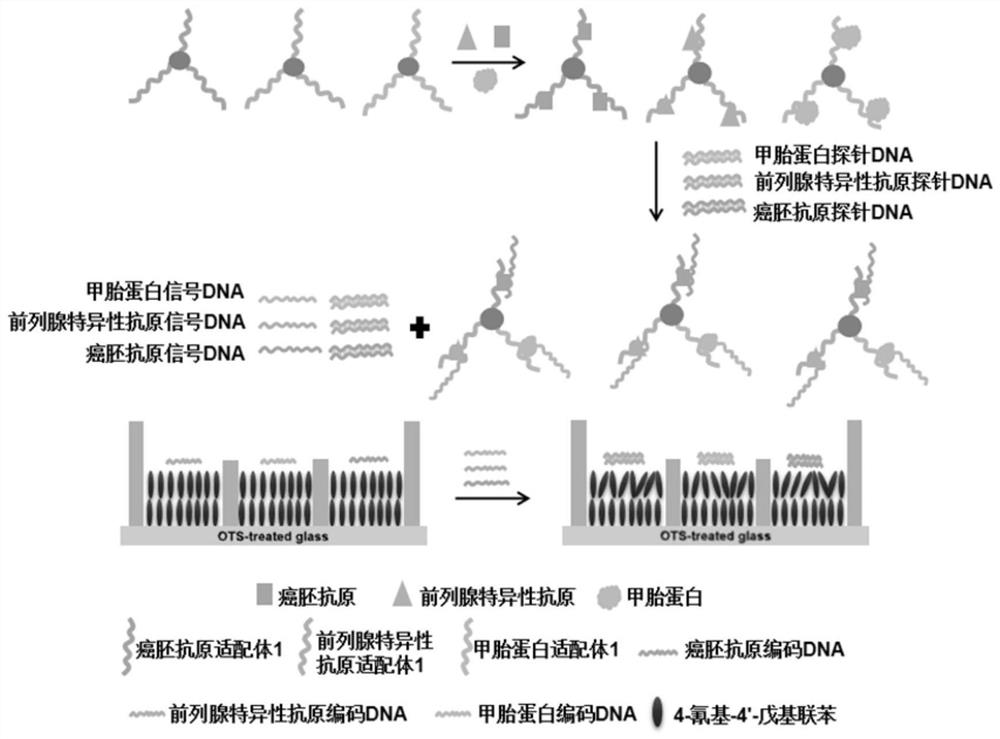Liquid crystal biosensor capable of simultaneously detecting multiple cancer markers and preparation and detection method of liquid crystal biosensor
A technology of cancer markers and biosensors, applied in the field of analysis and detection, can solve problems such as difficult coding and restrictions on the practical application of liquid crystal biosensors
- Summary
- Abstract
- Description
- Claims
- Application Information
AI Technical Summary
Problems solved by technology
Method used
Image
Examples
Embodiment 1
[0058] Embodiment 1: Preparation of liquid crystal biosensor
[0059] A method for preparing a liquid crystal biosensor for simultaneously detecting multiple cancer markers, the steps are as follows:
[0060] (1) Preparation of glass substrate: Soak the glass slide in 60mL of the washing solution prepared by the volume ratio of 98% concentrated sulfuric acid and 30% hydrogen peroxide at a volume ratio of 7:3. soak for 30 minutes, then wash three times with water, absolute ethanol, and methanol respectively, blow dry with nitrogen, dry at 110°C for 12 hours, place in DMOAP solution with a mass concentration of 0.5% at room temperature for 15 minutes, and wash with three times distilled water for 5 minutes. Second, blow dry with nitrogen, solidify at 105°C for 3 hours, and obtain a glass substrate after cooling;
[0061] (2) Preparation of multi-channel sample tank: 3D printing multi-channel sample tank, multi-channel sample tank includes individual channels and connecting chan...
Embodiment 2
[0066] Example 2: Method for Simultaneous Detection of Multiple Cancer Markers
[0067] A method for simultaneously detecting carcinoembryonic antigen (CEA), prostate-specific antigen (PSA) and alpha-fetoprotein (AFP), the steps are as follows:
[0068] S1. Preparation of capture magnetic bead probes: Mix 10 μL 0.1 mg / mL streptavidin-modified magnetic bead dispersion with 10 μL 0.4 μM biotin-modified CEA aptamer 1 solution, prostate-specific antigen Aptamer 1 solution and alpha-fetoprotein aptamer 1 solution were co-incubated at 37°C for 0.5 h, then the magnetic beads were separated from the solution using a commercially available magnetic separation rack, the solution was discarded, and the magnetic beads were washed with phosphate buffer solution 3 Once, three kinds of capture magnetic bead probes were prepared, and then the three kinds of capture magnetic bead probes (1 μg each) were dispersed into 30 μL phosphate buffer at the same time, and shaken to obtain a mixed disper...
Embodiment 3
[0080] Embodiment 3: Detect CEA, PSA and AFP of unknown concentration in blood
[0081] The preparation of capture magnetic bead probe and double-stranded signal probe is the same as that in Example 2.
[0082] The blood sample is tested immediately after being drawn, and the sample used in this embodiment is a blood sample of a healthy person.
[0083] Take 2 μL blood sample, dilute it 5 times with phosphate buffer, mix the dispersion with 10 μL 0.1 mg / mL capture magnetic bead probe, incubate at 37°C for 30 min, separate the magnetic beads with a magnetic frame, discard the solution, and use Wash 3 times with phosphate buffer, disperse the washed capture magnetic bead probes into 100 μL 10pM double-stranded signal probe mixed solution, incubate at 37°C for 30 min, separate the magnetic beads with a magnetic stand, and take the supernatant solution was added to the communication channel of the multi-channel sample tank of the liquid crystal biosensor prepared in Example 1, an...
PUM
 Login to View More
Login to View More Abstract
Description
Claims
Application Information
 Login to View More
Login to View More - R&D
- Intellectual Property
- Life Sciences
- Materials
- Tech Scout
- Unparalleled Data Quality
- Higher Quality Content
- 60% Fewer Hallucinations
Browse by: Latest US Patents, China's latest patents, Technical Efficacy Thesaurus, Application Domain, Technology Topic, Popular Technical Reports.
© 2025 PatSnap. All rights reserved.Legal|Privacy policy|Modern Slavery Act Transparency Statement|Sitemap|About US| Contact US: help@patsnap.com



